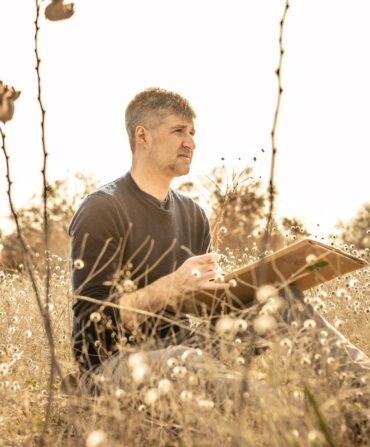Sporting South
This is Quail Country
Sporting traditions, conservation, and history abound on the plantations of Thomasville, Georgia
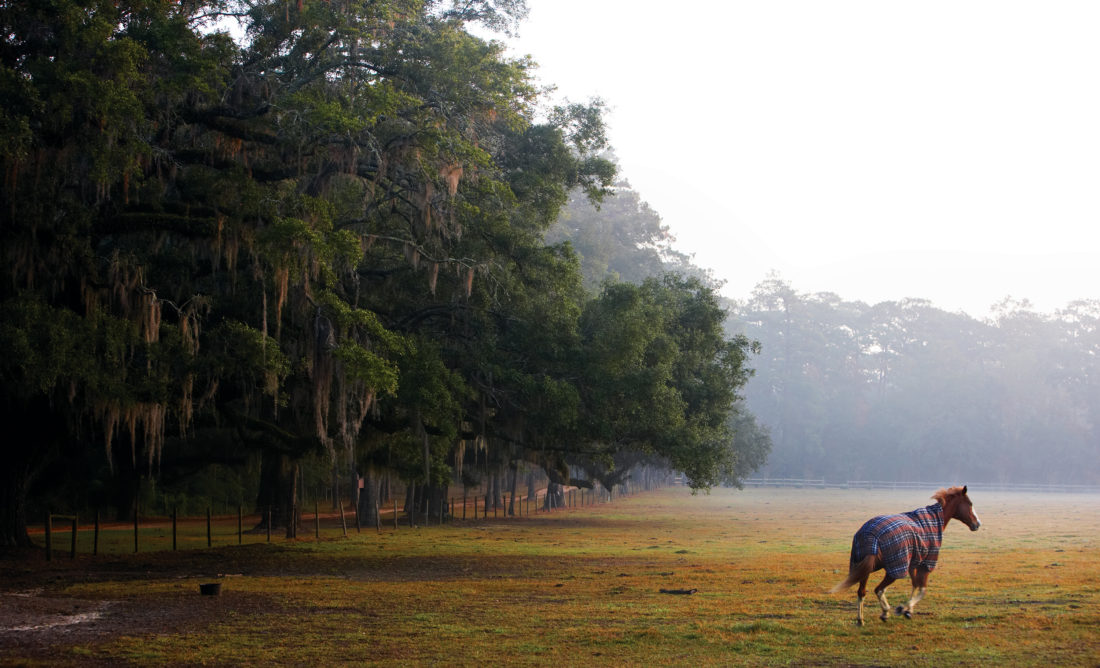
Photo: Robb Aaron Gordon
Boss, we got a point,”the huntsman calmly announced after tipping his hat and smiling amid the towering pines. He said nothing about hurrying, and not the first word about how these were wild birds and sure to get moving real quickly.
These Thomasville, Georgia, birds were unquestionably wild, and I was not going to let them flush before I — at slightly north of age thirty and known as Dead-Eye Dick on no fewer than three continents — had a chance to show my host a thing or two. We had never hunted together, and I was determined that he would appreciate that I had actually done this more than once or twice back in South Carolina. As I began to dismount, an assistant dog handler stood nearby and grabbed the reins. I loaded the 20-gauge Browning over-and-under, which I borrowed from my father, and looked toward the huntsman, who smiled and asked someone named “Mr. Charles” to walk toward a pine tree at which he was pointing.
Mr. Charles?
Oh, and there was no march-to-hell dash directed from a barking Bubba guide, or an air of guilt about slow hunters letting them get away, which they did, flushing before we were both in place on that first point. It was different here: It was Thomasville.
We rode on through the sweet-smelling pinelands. Bluebirds were warbling sunnily in the aromatic air. Woodpeckers were noisily calling and hammering. Behind us I heard the quail that we had been after, already calling together. High in the dreamy pines a warm wind murmured. All life seemed contented; I know that I was. – Archibald Rutledge, Bolio and Other Dogs, 1930
It has been more than ten years since i had the opportunity to hunt that particular exemplary old-school operation in the Red Hills, but I continue to make at least an annual pilgrimage to Thomasville, appreciating it more each visit.
My college roommate Richard Parvey did not know the first thing about hunting when I met him. Twenty-plus years later my buddy is living in this mecca of quail hunting and frequently outshooting me on Tahlequah, his plantation near the Florida-Georgia border. He and his wife, Elizabeth, own the place with New Hampshire-based entrepreneur Todd Enright and his wife, Robin.
The Parveys and Enrights recently asked my wife, Susan, and me to join them for another adventure in this legendary old-school bird hunting land, where preservation and tradition are sacred.
You may find plenty of quail hunting operations scattered across Alabama, South Carolina, Mississippi, Tennessee, and elsewhere, but you will not find the number of properties and the quality of habitat that exist in Thomasville and the surrounding North Florida-Georgia plantation belt. Thanks to the highest concentration of well-maintained bird hunting plantations in the South outside of Texas, Thomasville has been able to preserve traditional bird hunting in unrivaled scale and quality.
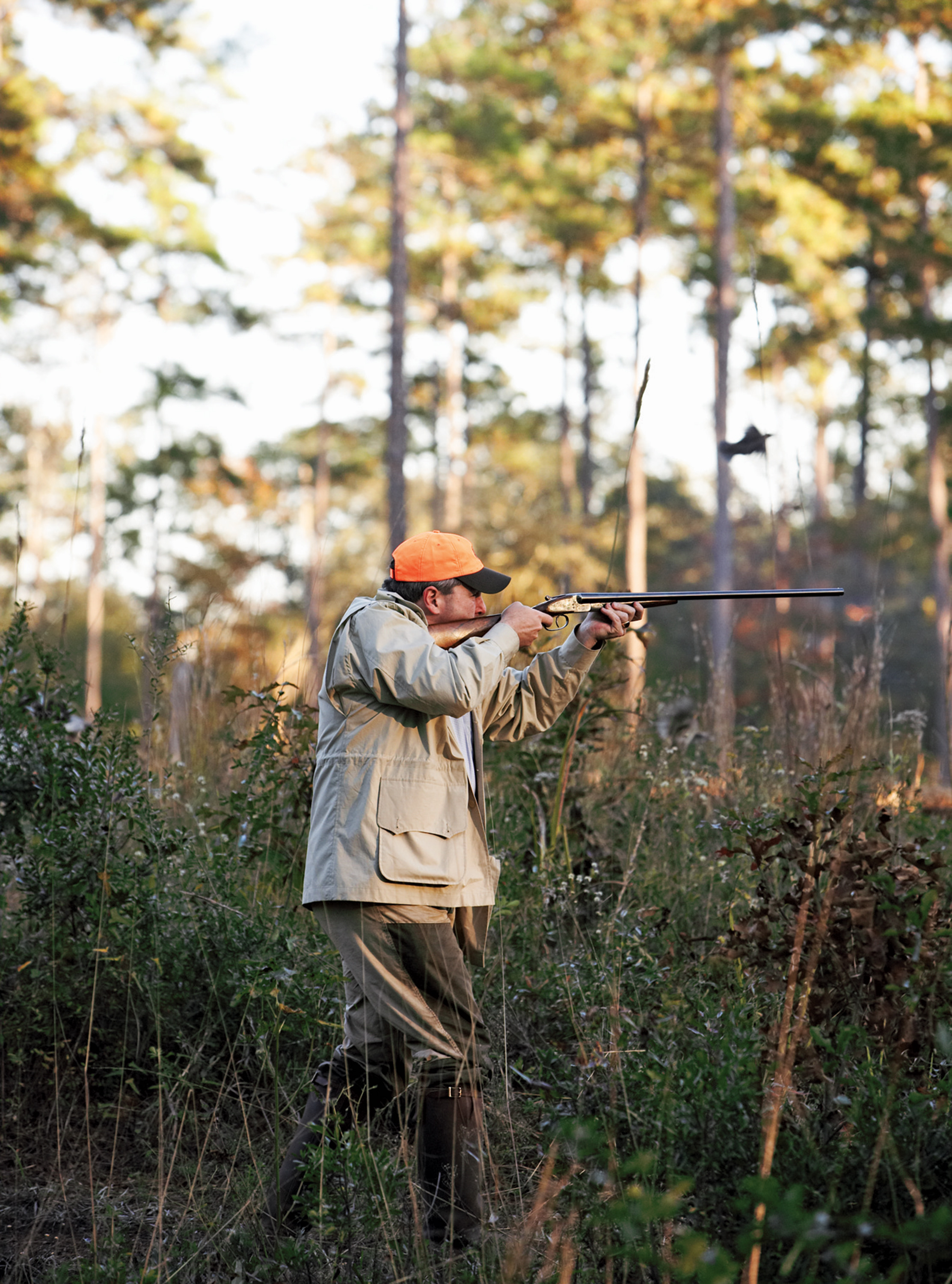
Photo: Robb Aaron Gordon
The author shoots quail along the tall timbers
Plantations here can range from a bit less than one thousand acres to more than twenty thousand — though you don’t ask about someone’s acres in this part of Georgia unless you are studying “the map,” a large sheet of paper that explains more than any book or history lesson. Various colors set apart vast circles and squares and connected rectangles of land that form more than three hundred thousand acres of the best quail habitat in the country. Often found near a landowner’s bar or gun room, the map tells you who owns what — and where you are hunting — and it is a fascinating trigger for discussions about the enormity and richness of this area where bird hunting is a seasonal religion.
What Aspen is to skiing, Thomasville, this understated town of twenty thousand, is to bird shooting. And though it attracts hunters by the thousands, on this visit, as I do on each one, I count the ways in which the rest of the world could never love the Red Hills as much as I do.
Hunting with Style
Our hunting weekend began with a feast supper at Liam’s, a popular restaurant in downtown Thomasville. A short distance from the plantations, the quaint town was one of the first in Georgia to recognize the importance of historic preservation, and to date, its Main Street revival program has restored more than one hundred buildings. Most storefronts are freshly painted and ready for the seasonal shooting crowd, which tends to include a fair share of high-profile types, including Jimmy Buffett, Ted Turner, Sonny Perdue, and Dick Cheney. The locals are generally cool customers about celebrities, rather accustomed to seeing famous visitors in their town.
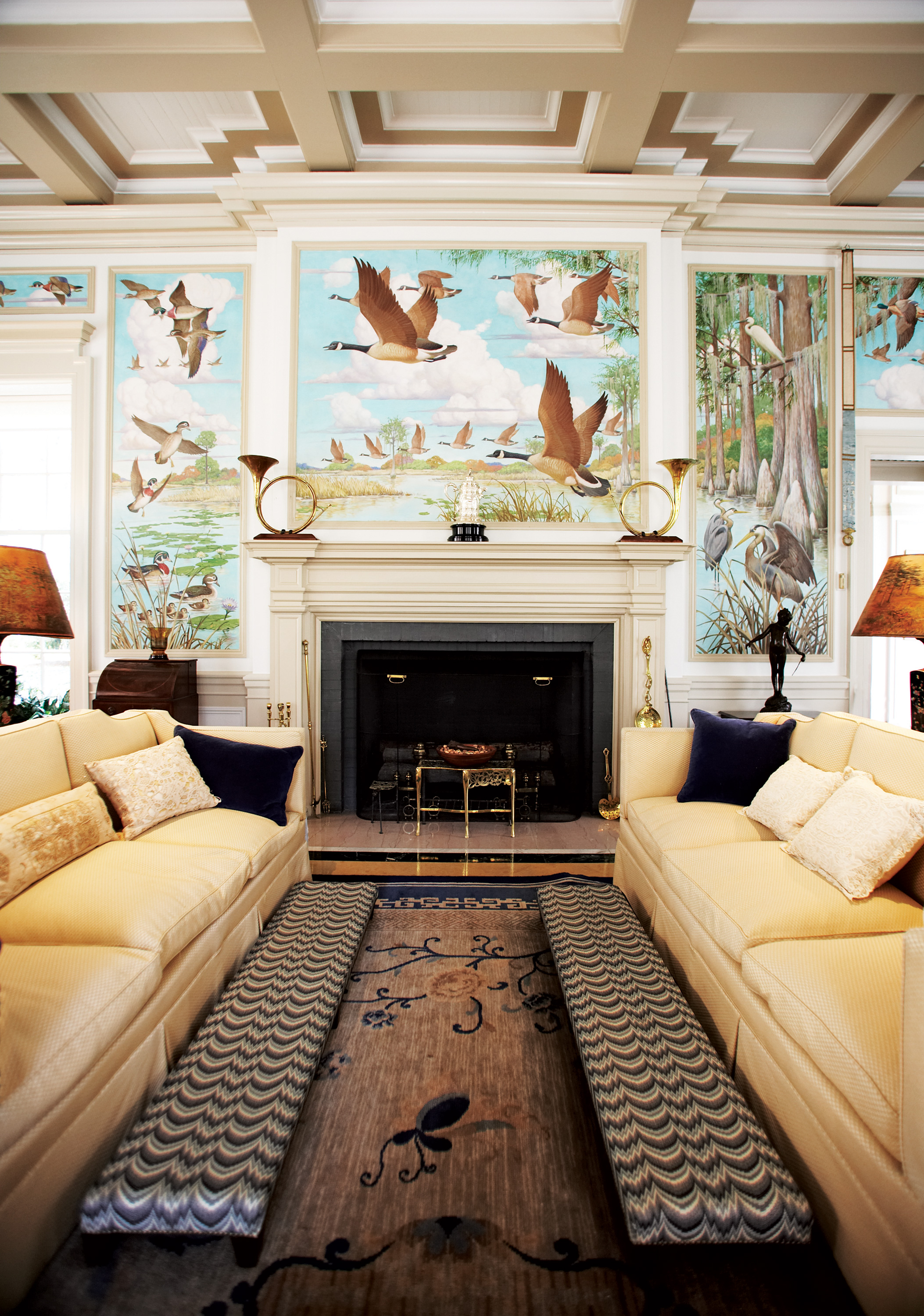
Photo: Robb Aaron Gordon
The walls of the big room at Pebble Hill Plantation include a wildlife mural by Clinton Shepherd.
The following afternoon, after a lunch at Relish, we were off to Tahlequah. We pulled through the gates and continued down a dirt road until we came upon the handsome day-lodge with tall windows and gray-hued clapboard designed by Richard. We caught up with the rest of the hunting party, including children and all the support for an afternoon’s hunt — horses, dogs, trailers, mule wagon, huntsman, dog handlers, and wagon driver.
As is often the case in the Deep South, the weather was mild, and the pine canopy — a mixture of longleaf and loblolly — provided cool shade. Red clay hills offer variety to the landscape, as do the wire grass and the various new grasses that come after controlled burns. As a result of intensive land management, a full hunting party can navigate in the pines with relative ease: The pines are spaced apart, and the understory consists merely of what has sprouted since the spring burns.
The full-scale Thomasville bird hunt begins and ends with a certain attitude, a style that has less to do with money than with hunting etiquette and respect for a tradition in which all participants are part of something larger than a day in the field. Residents treat their property, sport, and traditions with reverence.
In Southern style, here you hunt at the direction of the huntsman, or hunt master. Our huntsman, Steven Jones, learned a great deal while managing a commercial operation before the Enrights hired him three years ago. In his early years, he learned at the feet of his grandfather, an accomplished dog trainer.
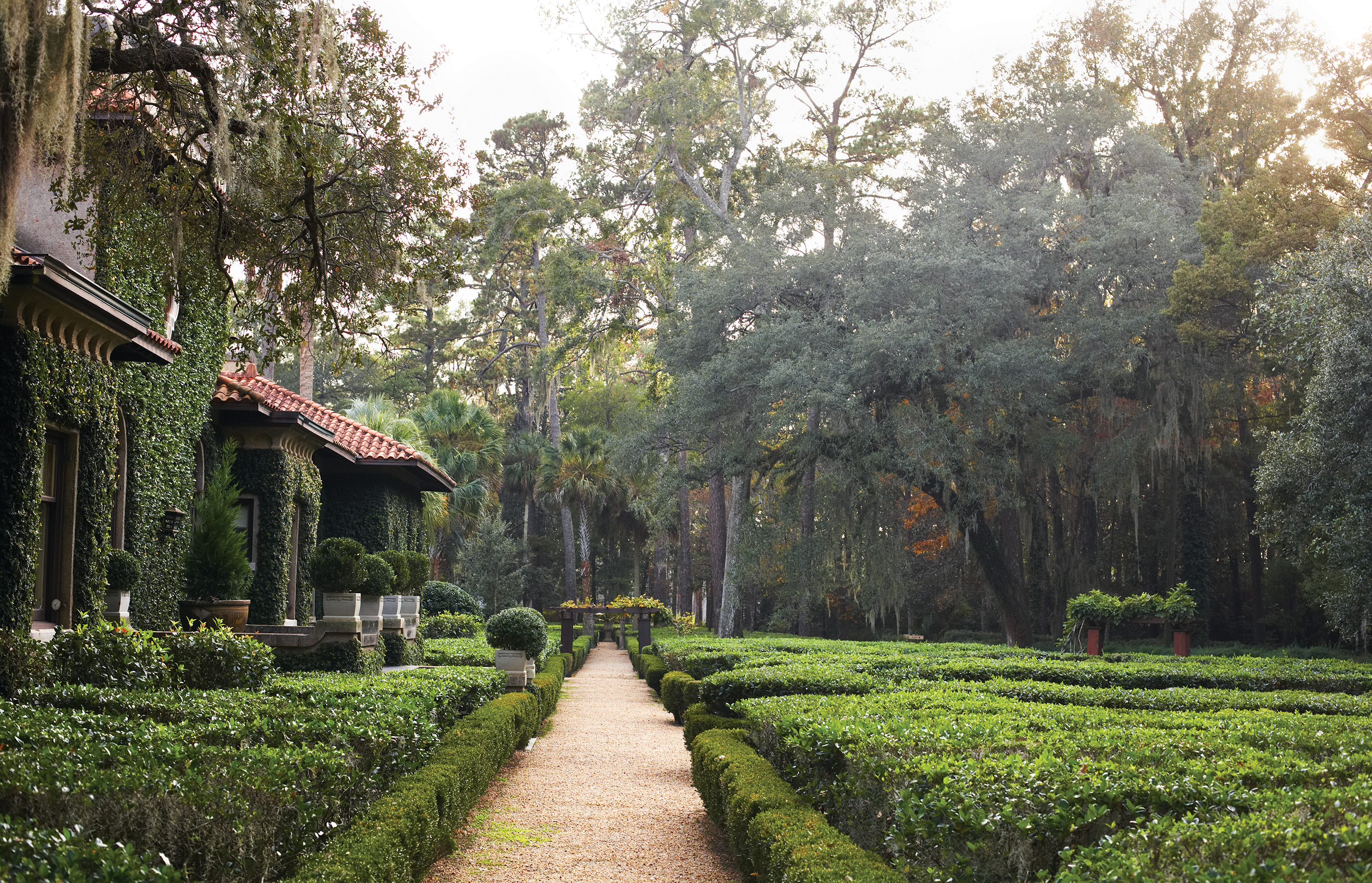
Photo: Robb Aaron Gordon
Natural Beauty
Millpond is a Spanish Mission-style plantation designed by Hubble and Benes. The gardens, designed by Warren Henry Manning, are a rectangular expanse of grass framed by paths and surrounded by Scottish pines and palms. Manning was a promoter of a naturalistic approach to garden design, emphasizing preexisting flora.
On this day Jones had three assistants and a mule wagon with driver, who, on the most formal of hunts in Thomasville, may offer a rabbit-fur blanket to his passengers. Wagons hold observers, the dogs, extra gear and guns, water for the dogs, additional pointing dogs, one or two retrieving dogs, and refreshments or a full lunch.
The four hunters, including Todd and Richard’s friend Bill Ladson, were on horseback. It could not have been five minutes before Todd and Bill were walking to the ramrod-straight pointers, certain that birds were near. Quickly, each sportsman dropped a bird, and the crew on the mule wagon released a Labrador to find the first of the day’s bounty.
Richard and I were up next, and knowing that a tighter pattern required better marksmanship, I was curious to see what I might accomplish with a full-choked L.C. Smith. Soon I had an opportunity to find the answer: I fired once, and my bird fell, but it was a while before it happened again that afternoon. Never hit the first bird of the day: It must be a curse.
A Storied History
The sport of bird hunting was quite common throughout the Deep South when quail were exceedingly plentiful. After the War Between the States, wealthy Northern industrialists purchased huge tracts for hunting and some developed an interest in the surrounding community and its citizens. Such was the case with late-nineteenth-century Thomasville: Word was that the air was good for the health — some promoters in South Georgia even claimed that the pine trees gave off a vapor that aided in the treatment of respiratory ailments — and the warm climate appealed to those suffering through bitter winters north of the Mason-Dixon Line.
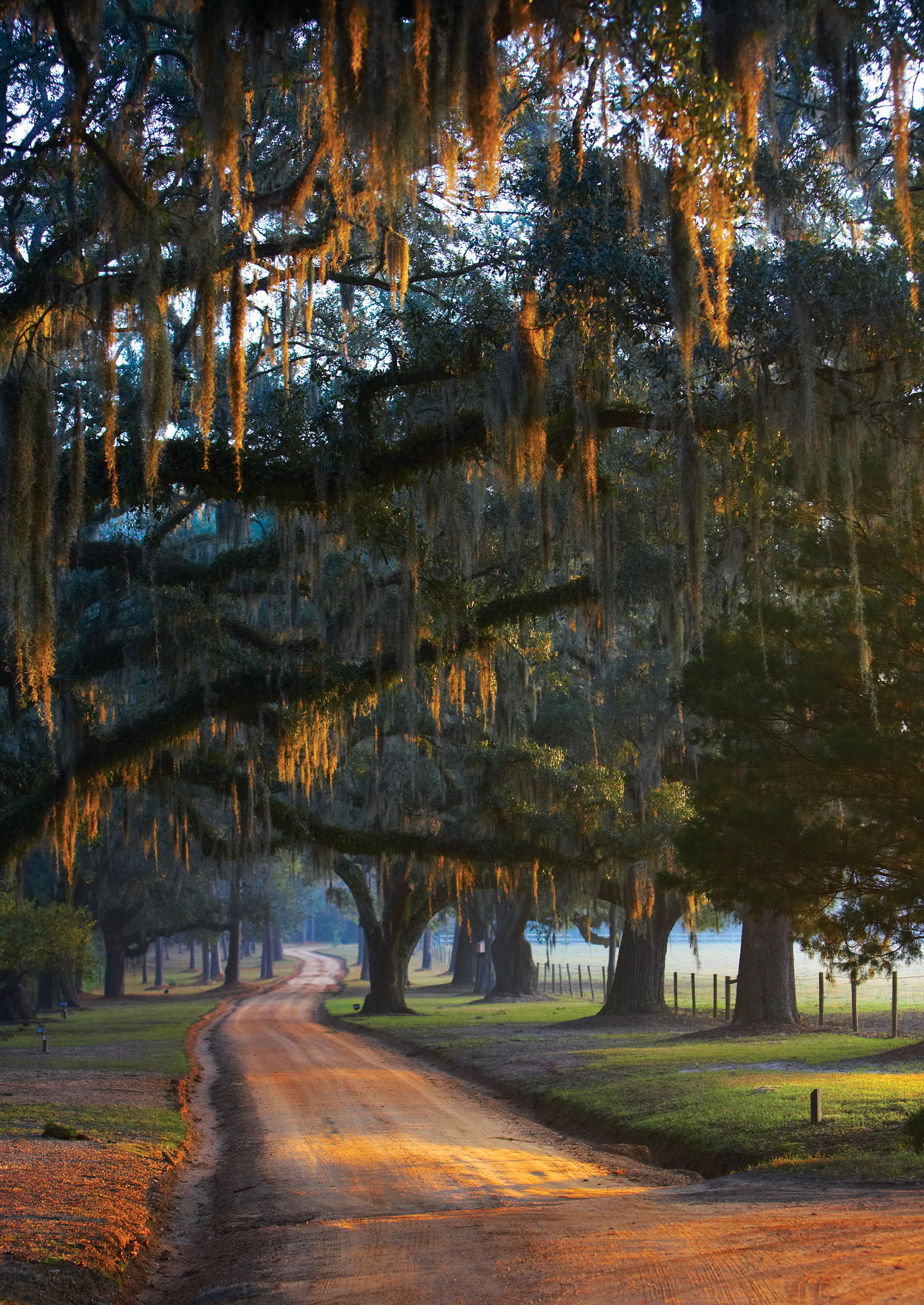
Photo: Robb Aaron Gordon
Spanish moss-covered oak trees line the drive to Coalson Plantation.
By 1897 Harper’s magazine had dubbed Thomasville “the best winter resort on three continents.” Downtown, where the railroad ended, a dozen hotels and twenty-five boardinghouses attracted Northern industrialists and socialites to spend the winter, away from the malaria-plagued Florida coast. They paid $4 a night for a room, but found they could buy an acre of land for $3.
The Deep South pine forests have inspired famous outdoor writers — among them, Archibald Rutledge and Havilah Babcock, who set a tone of wonder about bird hunting — as well as notable visitors.
Time magazine in 1954 wrote that President Eisenhower boarded a plane for thirty-six-hour getaways to Thomasville, to hunt quail on Milestone Plantation, belonging to then Secretary of the Treasury George Humphrey. According to Time, “Five minutes after he arrived … Ike was togged out in a natty corduroy cap, green windbreaker, whipcord jodhpurs, and (as a protection against the locally prevalent rattlesnakes) sturdy natural-leather boots. Under his right arm, the President carried two shotguns which he had carefully selected from his private collection: a standard 20-gauge double-barreled shotgun and his favorite, a small .410 over and under.”
Hunting and gun clubs have made roots in the Thomasville area for more than a century.As early as 1884, a particular gun club in Thomasville had thirty-two members, according to William Rogers’ Foshalee: Quail Country Plantation; and a sportsman remarked that one could expect to kill as many as one hundred and forty birds in a day — after a leisurely start. The start remains leisurely, but you are unlikely to hear anyone boast about numbers killed: Strict limits of a dozen per hunter are part and parcel of every hunting plantation here, though limits are far less important for restoring wild quail than plantation managers and huntsmen keeping close tabs on coveys and leaving enough birds — no fewer than four — in a “seed covey” to reproduce for the next season. Though there is no silver bullet for restoring wild birds, serious conservationists always focus on proper management of longleaf pine forests through regular burns, which help support the quail habitat.
By 1897 Harper’s magazine had dubbed Thomasville “the best winter resort on three continents.”
Back in the Saddle
On the second day of the hunt, we gathered a bit after ten at a leased parcel about fifteen miles from the first hunt. My appointed steed was a fine Tennessee Walker, and I found it ironic that his name was Dumpy, which didn’t do him justice at all. The day was set for midday sport followed by a full lunch in the field. Before we left on horseback, Todd greeted me at the barn with a handsome .410 Parker and insisted that I give it a try. It was a pleasure to contemplate hunting with a piece of history and elegance, but I had to “get right” with the L.C. Smith. I had a “misser’s hangover,” and my poor shooting from the previous day required the only cure possible: drop a bird cleanly.
The Parvey-Waring team was up first on this second day, and when Steven took off his hat briefly to signal a covey, Richard and I dismounted. The pointers performed and I sought to do likewise, picking one bird and watching it fall, then realizing that the darn “first bird curse” was now on the day.
Every hunter has theories to justify his bad shooting, so it is refreshing to witness someone who is simply on his game. Enter Bill Ladson. Having already shot with poise the previous day, Bill approached a covey late morning as we reached the top of a hill that looked over a dry cypress swamp. Todd took the right flank as his partner took the left. They both shot twice, and though I was not in a position to see the aftermath, I did notice how Richard’s chin moved forward as he looked at the results of the gunfire.
“He got three!” Richard exclaimed. A cocker spaniel puppy named Peetie hopped from the mule wagon toward Steven and his assistants, and he quickly stole Bill’s thunder, though we all remained witnesses to Bill’s fine shooting. Although Peetie’s retrieve was imperfect, the mule wagon and the rest of the party gave the dog a round of applause.
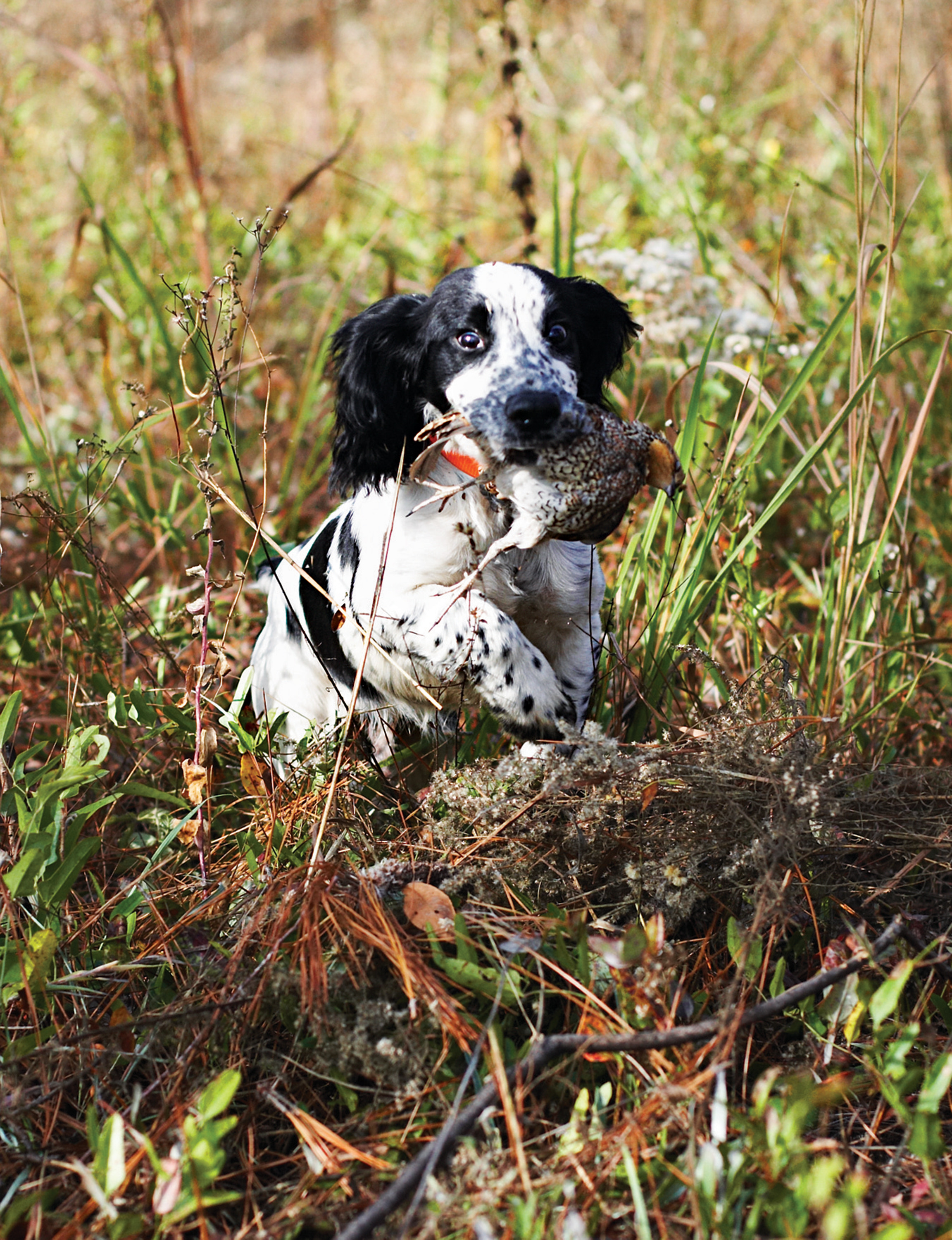
Photo: Robb Aaron Gordon
Peetie, the star of the hunt
Following this brief dog show, we stopped at a point near an old fence line. A large beech tree muted orange and brown from the hill as the Parvey-Waring team moved in, and this time I carried the Parker. Roughly a dozen birds exploded across the landscape, but my first shot hit nothing. I watched as the second trigger did the trick, and the moment morphed into a daydream of shooting one of America’s finest shotguns in a setting that only A. B. Frost could have captured. So, I asked: What is the rest of the world doing? Nah, I would not go there. It was time to hunt on.
Saving the Wild Quail
In spite of the best efforts of many dedicated sportsmen, the wild quail population has been on the decline since the late 1940s.
Causes range from loss of habitat to modern farming practices to fire ants and a proliferation of predators such as raptors, coyote, fox, raccoon, and opossum. From 1962 to 1998 the quail harvest in Georgia fell from four million to less than a million, and the per-hunter annual bag declined from about thirty to twenty.
Many committed organizations are trying to reverse these trends and find ways to restore wild bird populations, mostly through the preservation and restoration of habitat.
Quail Unlimited battles the problem of dwindling quail through awareness programs and initiatives to increase food, water, and cover sites for quail, and initiatives to educate on practices that help preserve the quail, such as controlled burns and leaving grain standing at the edge of fields for winter feeding.
In South Georgia, the famed Ichauway Plantation has a center promoting good resource management and general habitat conservation; it also conducts research dealing with the ecology of longleaf pine woodlands and their wildlife.
In Tallahassee, Florida, Tall Timbers, through its Game Bird Program, carries out important land management and forestry research to help quail: Its mission is to foster exemplary land stewardship through research, conservation, and education.
Quail Forever is another group dedicated to the protection and enhancement of the quail habitat. Founded by Pheasants Forever, which has helped promote significant land and wildlife conservation programs, including the bobwhite buffers initiative for quail conservation, it is involved with some of the country’s leading quail biologists and with the first-ever national plan for quail recovery.
To learn more or to get involved, visit Quail Unlimited at qu.org; Tall Timbers at talltimbers.org; Ichauway at jonesctr.org; Quail Forever at quailforever.org.





